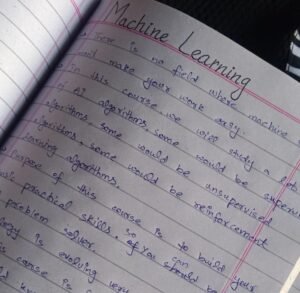Hey everyone! 👋 I’m excited to document my ongoing Machine Learning (ML) journey with Awfera, where I’m not just passively absorbing information but actively supplementing lectures with my own research—doing research, implementing concepts and comparing different learning resources.
Before we dive in, I want to express my deepest gratitude to Sir Irfan Malik and the entire Awfera team for democratizing AI education by offering this high-quality program completely free. This is truly a rare opportunity! Special thanks to our brilliant mentor, Dr. Shazia Saqib, whose academic excellence and industry experience make her the perfect guide through this complex field.

Now, let’s unpack everything I’ve learned so far, with deeper insights, researched facts, and practical examples!
Lecture 1: Introduction to Machine Learning, Building the Foundation
(Mentor: Dr. Shazia Saqib)
Understanding Our Mentor’s Expertise
Dr. Shazia Saqib isn’t just another instructor, she’s an academic powerhouse in Pakistan’s AI landscape:
- Currently Dean at the School of Informatics and Robotics, Institute for Art and Culture (Lahore).
- Former Dean of Computer Science at Lahore Garrison University.
- Extensive experience at DC University and the Institute of Cost and Management Accountants of Pakistan.
Her transition from traditional computer science to cutting-edge AI/ML roles shows how rapidly this field is evolving and is a lesson in itself about the importance of continuous learning.
Why Machine Learning Matters Now More Than Ever
We’re not just studying another tech trend but we’re preparing for the Fourth Industrial Revolution. Consider these facts:
- The global AI market is projected to grow from 136 billion(2022) to1.8 trillion by 2030.
- 87% of companies are actively using or exploring AI adoption.
Real-world impact examples:
- Healthcare: Google’s DeepMind can detect 50+ eye diseases with accuracy matching human doctors.
- Agriculture: Startups like Blue River Technology use ML for “smart spraying,” reducing herbicide use by 90%.
- Finance: JPMorgan’s COiN platform reviews 12,000 contracts in seconds (vs. 360,000 lawyer-hours annually).
The Three Pillars of Machine Learning
Mam Shazia introduced ML’s core paradigms, each with distinct philosophies and applications:
- Supervised Learning (The Guided Approach)
- How it works: Learns from labeled data (input-output pairs).
- Example: Predicting house prices based on features (sq. footage, location).
- Unsupervised Learning (Finding Hidden Patterns)
- How it works: Discovers structure in unlabeled data.
- Example: Customer segmentation for targeted marketing.
- Reinforcement Learning (Learning by Trial & Error)
- How it works: Agent interacts with environment, receives rewards/penalties.
- Example: AlphaGo mastering the game of Go.
Research Insight: A 2023 Nature study showed that reinforcement learning is now being used to control nuclear fusion reactors, optimizing plasma containment in ways humans couldn’t design manually.
Who Should (and Shouldn’t) Pursue ML?
✅ Ideal Candidates:
- Programmers comfortable with Python (Pandas, NumPy basics).
- Math enthusiasts (especially linear algebra, calculus, statistics).
- Problem-solvers who enjoy iterative experimentation.
🚫 Challenging For:
- Those expecting quick results without mathematical rigor.
- Individuals uncomfortable with debugging models (where 80% of ML work lies).
Pro Tip: If you’re weak in math, focus first on applied statistics, concepts like normal distributions and p-values appear everywhere!
Lecture 2: Decoding AI, ML & Deep Learning With Cutting-Edge Context
1. The AI/ML/DL Hierarchy Demystified
Let’s visualize their relationship with a tech stack analogy:
Artificial Intelligence (AI)
→ Machine Learning (ML)
→ Deep Learning (DL)
→ Transformer Models (e.g ChatGPT)
Artificial Intelligence (AI)
- Definition: Systems performing tasks requiring human-like cognition.
- ANI vs. AGI:
- ANI (Narrow AI): Excels at one task (e.g., ChatGPT for text, MidJourney for images).
- AGI (General AI): Hypothetical systems with human-like versatility and is still decades away.
Machine Learning (ML)
- Core Idea: Learn patterns from data rather than follow hardcoded rules.
- Game-Changer: The 2012 ImageNet competition, where AlexNet (DL model) crushed traditional ML methods, sparking the DL revolution.
Deep Learning (DL)
- What makes it special?
- Neural networks with multiple layers (“deep”).
- Automatic feature extraction (no manual engineering needed).
- Limitations:
- Data-hungry: Requires massive datasets.
- Black box problem: Hard to interpret decisions (critical in healthcare/finance).
Research Frontier: Explainable AI (XAI) techniques like SHAP values aim to make DL models more transparent.
2. ML Applications; Beyond the Basics:
Mam Shazia covered standard examples, but let’s explore more emerging applications:
| Industry | Breakthrough Use Case | Company/Research |
|---|---|---|
| Climate Science | Predicting extreme weather with Graph Neural Networks | DeepMind (2023) |
| Mental Health | Detecting depression from voice patterns using ML | MIT (2022) |
| Wildlife Conservation | Poacher detection via drone imagery | WWF & Intel |
3. Underrated ML Concepts
- The Curse of Dimensionality: Why adding more features can hurt performance.
- Bias-Variance Tradeoff: The eternal struggle in model tuning.
- Data Leakage: A silent killer of model validity (when test data influences training).
4. Historical Milestones With Modern Parallels
| Year | Breakthrough | 2020s Equivalent |
|---|---|---|
| 1950 | Turing Test | LLM Turing Tests (GPT-4) |
| 1997 | Deep Blue beats Kasparov | AlphaFold solves protein folding |
| 2012 | AlexNet revolution | Generative AI explosion (2022-) |
Fun Fact: The first “AI winter” (1974-1980) happened because hype outpaced reality, a cautionary tale for today’s AI expectations!
5. The Future: Where Are We Heading?
- Multimodal AI: Systems processing text, images, audio simultaneously.
- AI Legislation: EU’s AI Act (2024) sets strict rules ML engineers must now consider ethics.
- Quantum ML: Early experiments show quantum advantage for certain ML tasks (Google, 2023).
Key Takeaways & Personal Reflections
Technical Insights
- ML is both art and science: Choosing the right algorithm (e.g., Random Forest vs. Neural Net) depends on problem context, not just accuracy.
- Data > Algorithms: Garbage in, garbage out. 80% of ML work is data cleaning (Google Research, 2021).
- Ethics Matter: Models can inherit biases (e.g., racist facial recognition) always audit your data.
Learning Strategy
- Hands-on > Theory: I’m trying to apply concepts practically.
- Community Learning: Joined Awfera’s fb group to collaborate.
Gratitude & Call to Action
This journey wouldn’t be possible without:
- Sir Irfan Malik‘s vision for accessible AI education.
- Awfera‘s commitment to democratizing knowledge.
- Dr. Shazia Saqib’s structured pedagogy.
To fellow learners: Let’s connect! Share your:
- Biggest ML “aha!” moment so far.
- Go-to learning resources.
- Questions, we’ll grow together!
For my ongoing machine learning journey, you can visit here.
#MachineLearning #AIForAll #Awfera #DeepLearning #DataScience #TechWithAyesha

